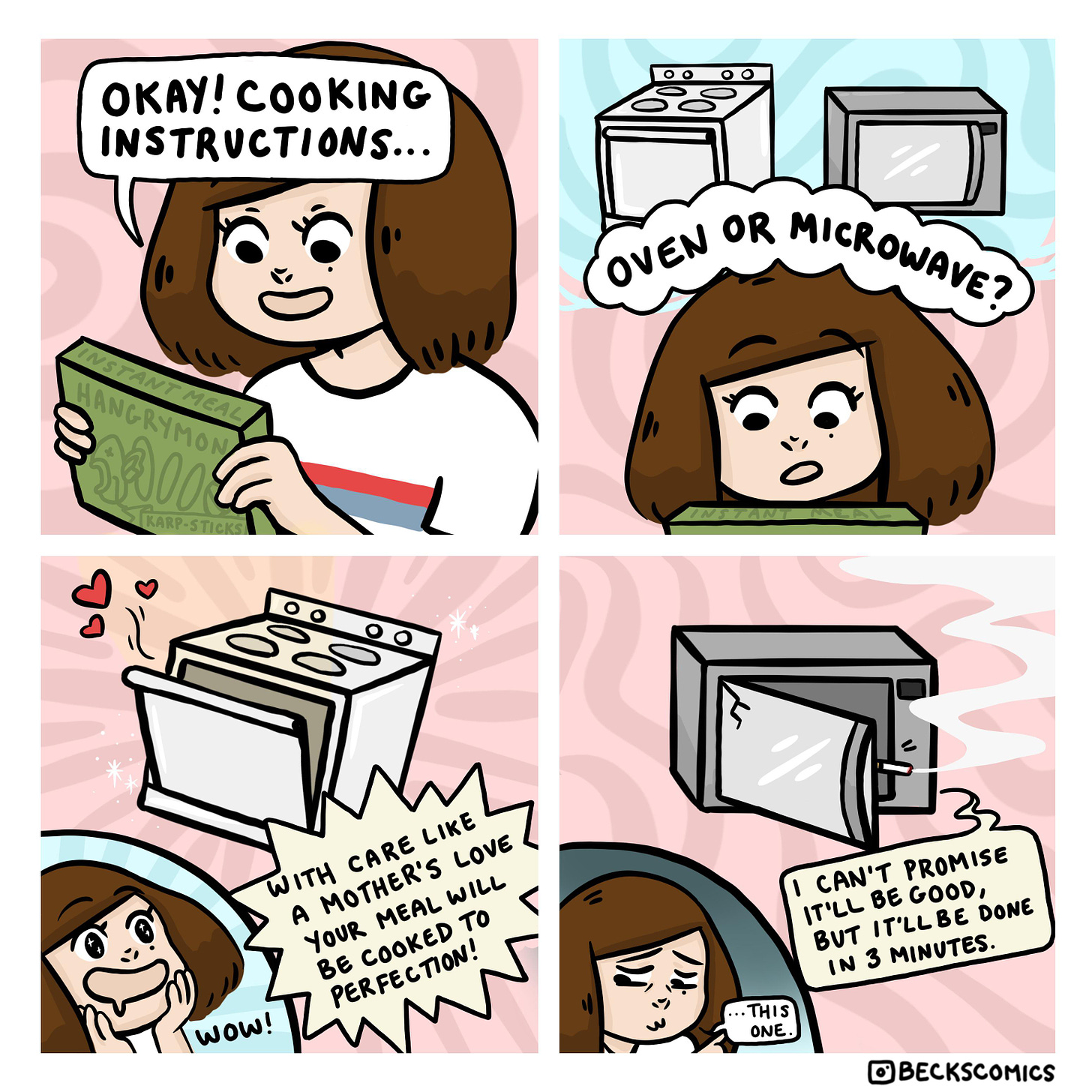Nudges are a way of changing people’s decisions and actions through small behavioral design principles. Simple adjustments in how you word messages or present choices to people can significantly impact their behavior. People don’t just rely on rational cost-benefit analysis when deciding between Choice A and Choice B; they also rely on subtle contextual cues outside the immediate choice. If you want to learn more about basic nudging principles and what types of nudges work best, here’s one of my previous newsletters.
There’s a problem with nudging’s widespread popularity though. It’s now so broadly and quickly applied that people often take for granted that it will work as expected. But human psychology is complex and the same intervention can produce different outcomes in different circumstances. There are no shortcuts to good research, and when you need to be sure that your nudge design will be effective in a new scenario, you need to rigorously test it before applying it on a large scale.
So let’s look at what can happen when nudges go wrong. Sometimes, the costs are more than just wasted money and minor frustration. One misguided nudge in Texas may have bumped up people’s chances of dying in a traffic collision.

⚠️ A road safety nudge disaster
In a paper published in April 2022, researchers Hall & Madsen examined the effects of roadside messages that communicated traffic fatalities. The messages were designed to grab a driver’s attention and make them immediately aware of the risks involved in driving. Many crashes are caused by careless attention, so in theory, a salient reminder about imminent death should motivate people to drive more cautiously. Nobody wants to add themselves to a fatality statistic.
As Hall & Madsen explain in their paper: “Because of its low cost and ease of implementation, this campaign has spread to at least 28 states since 2012 and affected over 100 million drivers”.
But did the campaign actually work? One state—Texas—rolled out their campaign in a way that allowed the researchers to test its impact on actual traffic fatalities. Here’s an example message in Texas to demonstrate what the researchers were examining:

From 2012 onwards, the Texas Department of Transportation displayed these messages for one week per month. For the on-message weeks, the researchers analyzed crash statistics within a 10 kilometer range following each message and compared them to crash statistics within the same range during other weeks of the month (i.e. off-message weeks). For example, the researchers tested whether the number of crashes within a one-hour window (e.g. Thursdays at 2-3pm) differed between on-message versus off-message weeks of the same month.
In the first kilometer that people drove following a nudge message, the researchers found that crashes were 1.7% higher than with no message. In other words, on the same stretch of road during the same stretch of time within each week, people were more likely to crash their car if they drove past a message displaying traffic fatality numbers.
As people drove further away from the messages after passing them, the crash risk declined, presumably because the mental impact of the message gradually faded. But even at 8-10 kilometers following a message, there was still a slightly elevated risk, with 0.8% more crashes than usual.
This elevated risk appeared when analyzing the times at which messages were supposed to be shown according to Texas guidelines. But compliance with guidelines is rarely perfect. When the researchers constrained their analysis to only when they could verify that a message was indeed shown, the inflated risk of traffic collisions was even worse, with 4.5% more crashes occurring within 10 kilometers following a nudge.
This elevated chance of death wasn’t merely an artifact of the on-message weeks being inherently more dangerous than the off-message weeks. When the researchers compared crash statistics for the 10 kilometers of road before a message, they found no differences between turning the message on or off. The problem emerged only after the messages grabbed people’s attention.
In fact, it’s this grabbing of attention that may have caused the problem in the first place. The most harmful messages were those that communicated the highest numbers of deaths, possibly because more deaths grabbed more attention. Since our attention is limited, spending our mental resources on processing a dramatic sign while driving leaves us with fewer mental resources to process the road in front of us. When we pay less attention to the road, we can’t respond as effectively to sudden hazards, and we’re more likely to drift out of our lane or get too close to the car ahead.
A 4.5% increased chance of a car crash is no trivial matter. As the researchers explain in their paper: “Based on prior research, this is comparable to raising the speed limit by 3–5 miles per hour (van Benthem, 2015) or reducing the number of highway troopers by 6%–14% (DeAngelo and Hansen, 2014). Our back-of-the-envelope calculations suggest that fatality messages cause an additional 2,600 crashes and 16 fatalities per year in Texas alone, with a total social cost of $377 million per year.”
⭐️ Takeaway tips
Beware of distractions: When you’re trying to work and a phone notification grabs your attention, it might make you less productive. But when you’re driving a car and suddenly feel distracted, it can kill you. We generally don’t fear cars as much as we should, and that confidence contributes to the tens of thousands of yearly traffic fatalities in the US alone. When the stakes are high, practice keeping your attention where it’s needed, and don’t let distractions increase your chance of injury.
Good intentions can have bad outcomes: The world is full of surprises and well-meaning actions don’t always produce good consequences. Contingency plans are the backbone of good forward-thinking. Don’t shy away from taking risks and working toward ambitious dreams, but have your Plan B ready to go in unfortunate circumstances. A good fallback will protect you, but it should be part of your equation from the beginning so that you can promptly apply it when necessary.
The importance of testing nudges: If you work in areas such as policy-making or behavioral research, don’t take for granted that a nudge will work as intended. There’s no substitute for good, comprehensive research, especially in fields that are rapidly growing in popularity and application. Nudging is popular because it can achieve surprisingly positive effects from surprisingly small investments. But that potency can just as easily produce significant harms. Test new behavioral interventions on a small scale before applying on a bigger scale, and look for negative as well as positive outcomes. Don’t assume an intervention will work just because it seems sensible.
💡 A final quote
“Expect the best. Prepare for the worst. Capitalize on what comes”
~ Zig Ziglar
❤️ If you enjoyed this, please share it with a few friends. If you’re new here, sign up below or visit erman.substack.com
📬 I love to hear from readers. Leave a comment on this post or feel free to email me your questions.
👋 Until next time,
Erman Misirlisoy, PhD




very interesting result, but your tacit assumption that this is about distraction seem unwarranted, and even unlikely to me. In that case, there are MANY signs that say something attention grabbing. Do we have stats that all of these cause deaths? When those signs were not up, I wonder how attention grabbing the alternative messaging was?
I have a feeling that something else is going on. maybe it is a "fuck it" kind of thinking? or "everyone else is doing it".... not sure. but the distraction argument is best tested by using some non-driving related distractor if that is what one hopes to measure.